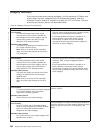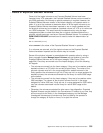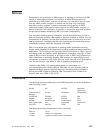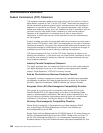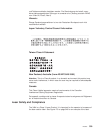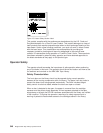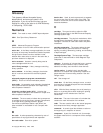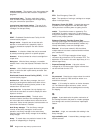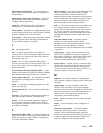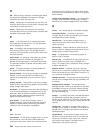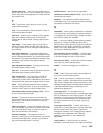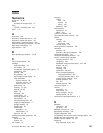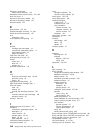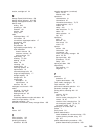control program. The program in the host system that
schedules and supervises the execution of application
programs.
convenience input. The term used when loading
small numbers of tape cartridges into the tape library
using the convenience input station.
convenience input/output station. The part of the
tape library used to load and unload small numbers of
cartridges into the tape library.
D
DCAF. Distributed Console Access Facility. A LAN
communication program.
Danger notice. A special note in text that calls
attention to a situation that is potentially lethal or
extremely hazardous to people. See also
Caution
notice
.
database. A collection of data that can be accessed
by a data processing system for a specific purpose.
demount. A host command to unload a cartridge from
a tape drive.
dialog box. With the library manager, a moveable
window, fixed in size, that requests information from the
user.
diskette. A thin, flexible magnetic disk and a protective
jacket, in which the disk is permanently enclosed. See
also
hard disk
.
Distributed Console Access Facility (DCAF). A LAN
communication program.
double-click. With the library manager, the act of
pressing a pointing device button twice within a time
limit while holding the pointing device pointer on the
selected item. See also
click
.
drop-down list. A drop-down list only displays one
item until the user takes an action to display the other
objects or choices.
dual active accessors (DAA). The dual active
accessors feature consists of two cartridge accessors
and microcode which enables them to be active at the
same time. Under normal operation, both accessors are
active when this feature is installed.
dual library manager. The dual library manager
consists of two library managers. Under normal
operation, one library manager is the active library
manager and the other library manager is the standby
library manger.
dump. To record data, at a particular instant, for the
purpose of safeguarding or analyzing.
E
EPO. See
Emergency Power Off
.
eject. The operation of moving a cartridge to an output
station in the tape library.
Emergency Power Off (EPO). A switch that removes
all power from the equipment in the IBM 3494 Tape
Library but does not affect power to lighting circuits.
enable. To provide the means or opportunity. The
modification of system, control unit, or device action
through the change of a software module or a hardware
switch (circuit jumper) position.
Enhanced Capacity Cartridge System Tape.
Cartridge system tape with increased capacity that can
be used with 3490E enhanced capability models only.
Visually identified by a two-tone cartridge case.
Ethernet. A local area network (LAN) that allows
multiple stations to access a data transmission without
prior coordination.
Export. The VTS Export operation allows logical
volumes to be moved from a VTS to another VTS. The
destination VTS can be in the same tape library or in a
different tape library.
Exported Stacked Volume. A physical volume
managed by a VTS that contains logical volumes that
can be removed from the VTS.
F
file protected. Pertaining to a tape volume from which
data can be read only. Data cannot be written on or
erased from the tape.
frame. (1) A housing for machine or device elements.
(2) The hardware support structure, covers, and all
parts mounted therein that are packaged as one entity
for shipping.
G
gripper. A part attached to the picker mechanism of
the cartridge accessor that loads or unloads cartridges
from storage cells and the Convenience Input⁄Output
Station.
H
hard disk. A rigid, non-removable disk residing in the
library manager.
high availability unit. A second library manager and a
second accessor.
342 Magstar 3494 Tape Library Operator Guide
|
|
|
|
|
|
|



